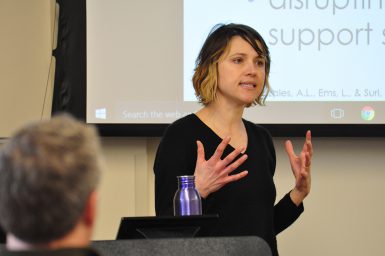Gonzales addresses technology, digital divide

Computer-mediated communication, social justice and social media meet at an intersection that can serve as a starting point in building social scientific theory.
Assistant professor Amy Gonzales discussed this intersection in her talk, “Technology Maintenance: Building a Social Scientific Theoretical Framework for the 21st Century Digital Divide,” Feb. 3 as part of the Media School’s weekly research talk.
Gonzales outlined several research studies she has conducted in observing and explaining “digital divides” between groups of people, especially those in marginalized groups. Access to digital technology can shape people’s life experiences and opportunities, she said.
“What does it mean if you don’t have access?” she asked. “What are the implications of that?”
In Gonzales’s first study she outlined, she looked at how people use phones for social support, conducting 33 interviews with low-income individuals who used free wireless programs—assurance phones or “Obama phones,” as they’ve been called.
“When your Obama phone runs out of minutes, you just don’t have a phone,” Gonzales said.
She noted that access to a phone does not necessarily equal stable access, and that old or malfunctioning technology in phones can further divide people.
In a second study, Gonzales interviewed local clients at an HIV clinic about their phone usage to understand how phone access affects healthcare opportunities.
“It didn’t really interrupt access to emergency healthcare,” Gonzales said of the lack of reliable phone access in clients, noting that they could borrow a phone in an emergency. “What really happens is it slows healthcare.”
A lack of phone access also means a lack of social support, she said. In one interview, a client described having few opportunities to contact family for support when the client’s father died.
In a third study, Gonzales surveyed 748 IU students about their phone and laptop usage, asking questions about their socioeconomic status and parent education levels as well. While students of lower socioeconomic status were less likely to borrow technology when in need, she said, they were more likely to turn to campus resources for access.
Gonzales is now looking at effects of stable phone access on communication rates, health and wellbeing. She is looking to test 50 people from local clinics on phone service compared to grocery gift cards in how they utilize these resources in shaping their wellbeing.
Next steps will focus on framing the problem for external grant purposes and in developing a second phase in the testing. Gonzales hopes to make the variables of interest continuous to allow for factor and path analyses, building on a similar methodology she has used in her past studies.
“Your identity as a scholar tends to evolve as you find things that are of interest to you,” she said.
Through this testing, and through these past studies, she aims to build stronger theoretical framework in considering the digital divide.

